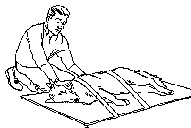
The first aid provider must not only identify and treat injury or illness, but must also safely transport the patient to the veterinary facility for further treatment. Improper technique when transporting a patient can result in further injury or complications, and risks a bite injury to the person transporting the injured pet. Although this article cannot fully prepare you for all specific examples, it can provide the following general recommendations.
Handle the Pet as Little as Possible
Try to make the pet comfortable by encouraging him to lie down and stay. Smaller dogs and cats can most effectively be transported in commercially available carriers or in a cardboard box with a lid.
Handle the Pet Gently
Rough handling may cause further internal bleeding, more damage to the soft tissues around a fracture, and many other complications.
Lie the Pet on its Side if Possible
If the pet seems to resent this or has more difficulty breathing on its side, it may indicate the pet has an injury to the chest or lungs. In this case, it is better to leave the pet in a comfortable position of his choosing.
Minimize Movement
If possible, gently tie or tape the pet to a flat surface such as a large board or piece of plywood. This is imperative when handling an unconscious patient or the patient with a suspected back injury to ensure that they do not thrash about – this could potentially make any internal or spinal injuries worse.
Do Not Put Pressure on the Stomach
This is most important for the pet who is having difficulty breathing, has been vomiting, or has pain in the abdomen.
Use a Backboard
Use a Backboard

Use a backboard. Illustration by Isaac Mayo
If the pet seems paralyzed or unable to get up, a spinal injury is suspect and the pet must be firmly immobilized to prevent further damage to the nerves. Get a firm, flat support (an ironing board, a piece of plywood, a collapsed cardboard box, a table leaf -- think of one in your house before you need it). Grasp the skin over the back of the neck and over the small of the back and gently slide the pet on to the support. Try to keep the back and neck straight. Gently tie or tape the pet to the support. As stated above, if this causes the pet to struggle, you will need to find another method of transport, such as a large blanket to use as a stretcher.
Position the Head
If the pet is unconscious, position the head in normal alignment with the body. It should not flex abnormally downward nor extend excessively upward. Improper flexing or extending can cause decreased blood drainage from the brain and cause serious damage. If the pet has vomited or appears likely to vomit, put the head down below the level of the heart. This will allow the vomitus to run out of the mouth and not down into the windpipe and the lungs. Be aware that pets with severe head injuries are likely to vomit, even while they are unconscious.
Cover the Patient with a Blanket
Covering an injured pet has a calming effect. More importantly, it prevents heat loss. A blanket can also be used as a transport device. In this case, the animal can be gently lifted with the blanket. Gently slide the pet into the center of the blanket. Roll the edges of the blanket to provide a better grip. Gently lift the blanket and the pet into the transport vehicle. This is usually a two-person procedure.
Know the Route to the Veterinary Facility and Call Ahead
Get precise directions and drive directly to the facility. This will result in the fastest delivery of the pet for professional care. Call them to let them know you are on the way.
Drive Carefully!
Driving out of control or in a panic may result in delays (while the officer writes a ticket) or injuries if you are involved in an accident.
Emergency situations require prompt and safe transport of the sick or injured pet. If done properly, this will give your pet a better chance for recovery. If delayed or done carelessly, the outcome may be less favorable. As with most first aid principles, prior planning and awareness of proper techniques will prevent many problems.
First Aid: A Final Note
Most veterinary hospitals are not open around the clock. Some may provide emergency service (meaning someone will meet you there if you call first). If you do not call first, you may arrive to find that a doctor is not available. To avoid wasting time in a crisis, ask your veterinarian ahead of time about emergency services available, and learn the shortest route to your veterinarian and to a 24-hour emergency facility, if one is available in your area.
Browse the complete Veterinary Partner First Aid collection.